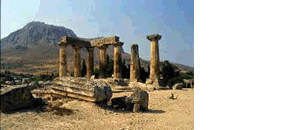 |
|
|
|
|
Class
Prep
|
|
|
|
- Greece:
Aeschylus' Oresteia, "The Kindly Ones"
-
 We have read now the dilemma central to the plot of the
Oresteia trilogy, which is that the human characters
are caught between two inescapable yet competing demands. Our
questions today are about how Aeschylus begins to resolve
that dilemma and about the employment of the Athenian religious
system in that undertaking.
We have read now the dilemma central to the plot of the
Oresteia trilogy, which is that the human characters
are caught between two inescapable yet competing demands. Our
questions today are about how Aeschylus begins to resolve
that dilemma and about the employment of the Athenian religious
system in that undertaking.
-
- As you review the plot of the second play, "Elektra"
(summarized in your book, pp. 123-9 and online)
and study the concluding play of the trilogy, "The
Eumenides" (which means literally "The Kindly
Ones"), consider the following:
-

-
- Become familiar with the plots of both "Elektra"
and "The Kindly Ones."
- What arguments are used in the prosecution and defense
of Orestes? Please list these in advance of class.
- What roles do Apollo (pictured above) and Athena (pictured
to the left) play in this plot?
- How is the central dilemma of the trilogy resolved?
- Why would the Furies be referred to as "The Kindly
Ones"?
-
-
- After discussing the trial and its resolution at the
story level, we will turn to the discourse or story-telling
level of the play. You received a handout in class that
charts three major internal and external pressures that
Athens was facing during the late 500s through the late
400s BCE (click here
for a pdf copy).
 Aeschylus
composed the trilogy during these tumultous years, years
that coincided with the flowering of Greek philosophy, political
theory, art and architecture. Aeschylus presented the trilogy
in one sitting for the Great Dionysia festival in Athens
in 458 BCE, perhaps at the Odeion at the base of the Acropolis
(to the right). As you consider the plot of the entire trilogy,
do you find any links between what Athens and the House
of Atreus are experiencing? To put it another way, what
links can we establish between the historical context when
Aeschylus wrote and the themes of what he wrote?
You do not need to fill in the chart in advance of class;
we will take some time in class to work on it. Aeschylus
composed the trilogy during these tumultous years, years
that coincided with the flowering of Greek philosophy, political
theory, art and architecture. Aeschylus presented the trilogy
in one sitting for the Great Dionysia festival in Athens
in 458 BCE, perhaps at the Odeion at the base of the Acropolis
(to the right). As you consider the plot of the entire trilogy,
do you find any links between what Athens and the House
of Atreus are experiencing? To put it another way, what
links can we establish between the historical context when
Aeschylus wrote and the themes of what he wrote?
You do not need to fill in the chart in advance of class;
we will take some time in class to work on it.
-
-
- Assigned Readings
- Primary: "The Kindly Ones (Eumenides)"
(pp. 207-271); if time is tight, be sure to read how the
play begins and then the final third of it (this is a
change from the original syllabus)
- Secondary: pp. 123-9 (= a summary of the middle
play, "The Libation Bearers"); 199-204; online
class prep
- Optional: "The Libation Bearers" (pp.
131-94; if you read this, read it before "The Kindly
Ones")
-
-
- Further Reading
-
 MacLeod, C. W. "Politics and the Oresteia." Journal
of Hellenic Studies102 (1982) 124-44.
MacLeod, C. W. "Politics and the Oresteia." Journal
of Hellenic Studies102 (1982) 124-44.
-
 Winnington-Ingram, R.P. "Clytemnestra and
the Vote of Athena." Journal of Hellenic
Studies 68 (1948) 130-47.
Winnington-Ingram, R.P. "Clytemnestra and
the Vote of Athena." Journal of Hellenic
Studies 68 (1948) 130-47.
-
 Zaidman, Louise Bruit and Pauline Schmitt Pantel. Religion
in the Ancient Greek City, trans. Paul Cartledge. New
York: Cambridge University Press, 1992; original, Paris:
Armand Colin, 1989.
Zaidman, Louise Bruit and Pauline Schmitt Pantel. Religion
in the Ancient Greek City, trans. Paul Cartledge. New
York: Cambridge University Press, 1992; original, Paris:
Armand Colin, 1989.
-
-
- Links
-
-
- Sources
- Photographs:
- C. Murphy, "Odeion of Herod Atticus in Athens,
skene (J-037)," 1988.
-
- "Reconstruction of the Athena Parthenos, Royal
Ontario Museum, Toronto, based on the work of Dr. Neda
Leipen," reproduced as Figure 103 in Mark D. Fullerton,
Greek Art (New York: Cambridge University Press,
2000) 143.
|
|
|
|
|
